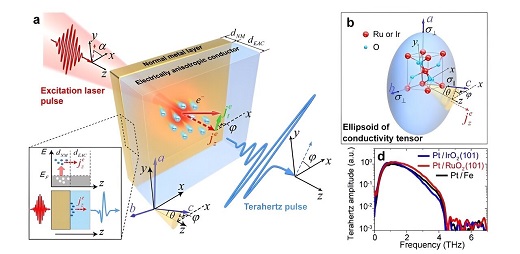by SPIE

A nonrelativistic mechanism for terahertz pulse formation using an electrically anisotropic conductor-based heterostructure (a), ellipsoid of the conductivity tensor of the anisotropic conductors RuO2 and IrO2 (b), and characterization of the generated pulse (c and d). Credit: Zhang, Cui, Wang, et al., doi 10.1117/1.AP.5.5.056006.
Scientists and engineers keep developing ever faster and more powerful technological devices. But there is a need for even faster and more efficient electronics. A promising route is to take advantage of terahertz waves, a less-explored part of the electromagnetic spectrum nestled between the infrared and microwave regions. Terahertz waves are uniquely sensitive to charge carriers in conducting systems, proving a powerful probe to understand the magnetic properties of new materials.
The quest for ultrafast electronics and coherent terahertz sources can be significantly aided by the precise and ultrafast control of light-induced charge currents at nanoscale interfaces.
Existing methods, including inverse spin-Hall effect (ISHE), inverse Rashba�CEdelstein effect, and inverse spin-orbit-torque effect, convert longitudinally injected spin-polarized currents from magnetic materials to transverse charge currents, thus generating terahertz waves. However, these relativistic mechanisms rely on external magnetic fields and suffer from low spin-polarization rates and relativistic spin-to-charge conversion efficiencies characterized by spin-Hall angle.
Against this background, a new study published in Advanced Photonics introduces a nonrelativistic and nonmagnetic approach that directly exploits the light-triggered high-density charge currents across interfaces.
This pioneering work was conducted by researchers from State Key Laboratory of Surface Physics and Department of Physics and Key Laboratory of Micro and Nano Photonic Structures (MOE) at Fudan University, Shanghai Research Center for Quantum Sciences, and Center for Advanced Quantum Studies and Department of Physics at Beijing Normal University in China.
The study harnesses the electrical anisotropy of two conductive rutile oxides: antiferromagnetic RuO2 and nonmagnetic IrO2. The single-crystal films of these oxides can deflect super-diffusive charge currents injected from an optically excited metal thin film, redirecting them from the longitudinal to the transverse direction. This process results in efficient and broadband terahertz radiation.
The researchers utilized various metals for the thin film, finding platinum (Pt) to be the most promising. They fabricated Pt/RuO2(101) and Pt/IrO2(101) thin film heterostructures and measured their terahertz amplitudes. The Ir-based system produced signals three-fold stronger, comparable to those generated by commercial terahertz sources based on nonlinear optical crystals and photoconductive switches.
In contrast to traditional approaches that rely on the conversion of charge currents to spin-polarized currents, the new method capitalizes on the inherent properties of conductive materials, eliminating the need for spin-polarization. In addition, this new mechanism offers a high terahertz conversion efficiency, comparable to that of the ISHE mechanism.
Notably, the use of conductive materials with highly anisotropic electrical conductivity, which are readily available, is key to enhancing the conversion efficiency. Thus, this approach promises greater flexibility and scalability compared to existing techniques, which are limited by the challenges in further increasing the spin-Hall angle of heavy-metal materials.
The implications of this technology extend beyond efficient terahertz-wave generation. It holds promise for energy harvesting, ultrafast electronics, and terahertz spectroscopy by tapping into the potential of high-density charge currents across metallic interfaces. This will lead to advancements in various modern technologies, including solar cells, artificial photosynthesis, and high-efficiency optoelectronic devices.

